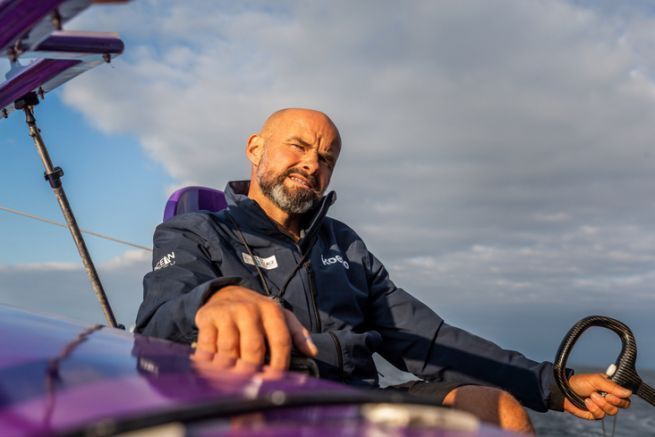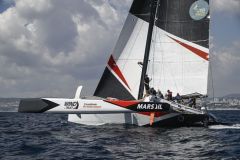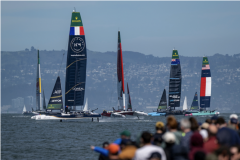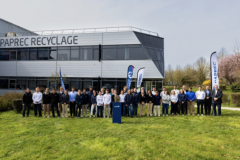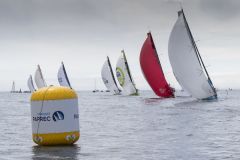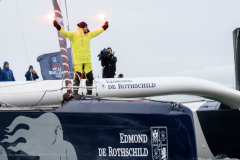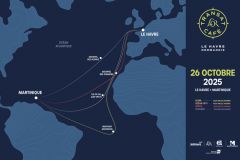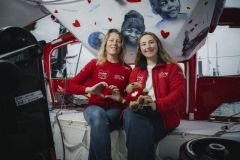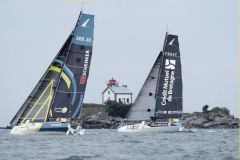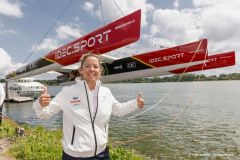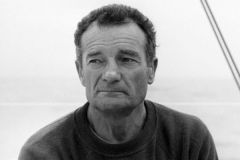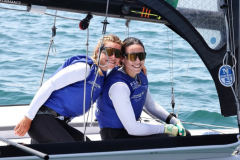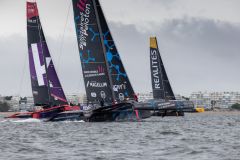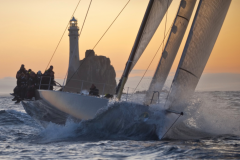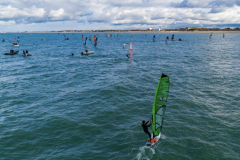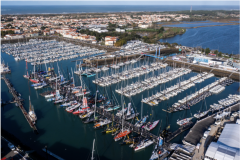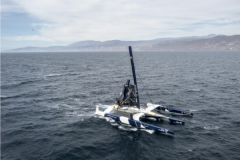You are back on the Ocean Fifty circuit, what motivated you to come back?
The motivation is quite simple. We spent some time with all the racers in the class and their partners during the Covid to create the Pro Sailing tour. This circuit that we have dreamed of, that I have dreamed of for years with Franck-Yves Escoffier.
Participating in the construction of this circuit and not being part of it caused me a slight frustration that had to be overcome. A series of opportunities made me find myself here today. I started in multihulls on ORMAs. It's a roaming circuit, a contact regatta. Offshore racing is a mixture of technical exercises around the boats.
You have already won the Jacques Vabre three times. How are you feeling and what is your goal? A 4th victory?
100% of the winners have already arrived on the other side! We're arriving with a new partner, a boat that is quite young even though we've sailed a lot of miles, especially on this Pro Sailing Tour 2021. It remains a new boat that has never seen a front. We have to use it sparingly, learn to use it, make it reliable, and be careful not to make any mistakes.
Can you tell us about your boat, Koesio, the former Planet Warriors of Fabrice Cahierc, and which is the last Ocean Fifty launched? What is your assessment of your first sailings and competitions?
It is a boat that we have rented until the end of the year with an option to buy. It is the last-born of the fleet. Its K-arms are its particularity. It is innovative in the shape of the Ocean Fifty structure. It has very flat arms, with very little stock, the part that joins the floats. It's really spider-shaped. It also goes further in aerodynamics. The structure of the boat is located between the two front and rear arms. It's barely 2 meters long. This is what makes the difference with other boats. It's a significant weight saving and it allows us to have a cockpit that is both clear and completely sheltered with a cap. It is almost a seceuros rule!
The performance of the crew is much more important under shelter than outside, wet all the time. I experienced this during the last Route du Rhum or the last Jacques Vabre on my old boat. We were under the water jet all the time! Physically it is very engaging, very energy consuming. Sailing protected frees up energy for adjustments and performance.
We can rest, eat, etc. This is a big plus in terms of life on board.
We can see that there is not a big gap between the boats in the fleet. The box rule is restrictive on sensitive points, which makes it a very homogeneous fleet. Any boat, even 10 years old, can win the Jacques Vabre. Arkema 4 can win, as can Leyton and P'tits Doudous. That's also the good thing. The pairings on board will make the difference.
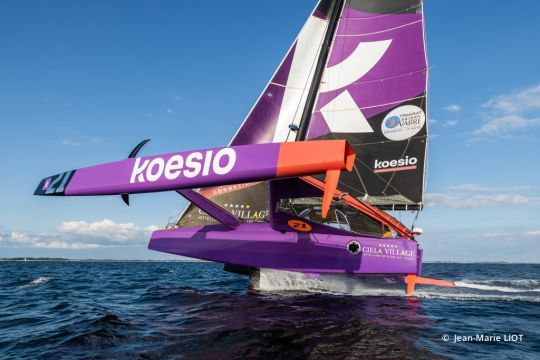
Since the Pro Sailing Tour, have you done any workcamps?
We dismasted to try Yves Parlier's Liberty kite and understand how the boat could work without a mast, with a kite. That confirmed us in the fact of taking one. In case of dismasting, we may be able to return by ourselves thanks to this system.
We also redid all the paint in 4 weeks. It's a big challenge. It also allowed us to do a little work to optimize the cap. We sail even drier than on the Pro Sailing Tour.
Why did you choose Xavier Macaire to accompany you on this Jacques Vabreeuros?
It's a choice of complementarity. I knew Xavier through his track record. We had the opportunity to sail together in Multi50 on Ciela Village on the Drheam Cum.
He's a golden guy. He's super nice. We speak the same language. It was easy right away. Today, the level in the class is very high. Xavier's contribution, his knowledge of contact racing and the development of an autonomous strategy helps us a lot. This is something we don't necessarily have in a multihull, as we have a router.
We realize that he has sailed the boat a lot. He brings rigor and creativity to the search for that little bit more speed. To go faster than the others. Decisions are made in a collegial atmosphere.
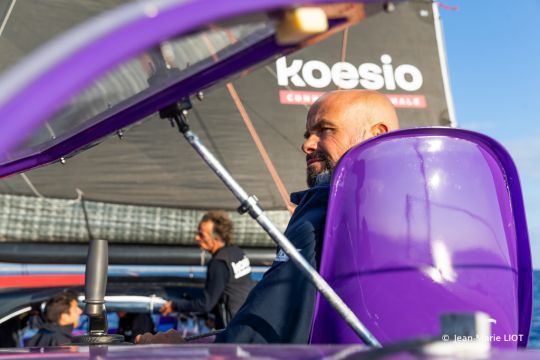
What are the constraints and advantages of a double-handed race format compared to solo or crewed racing?
There are no drawbacks. The double format is great. It's fake solo but the difficult, important, exceptional moments are shared by two. It's always better than being alone. It also allows you to share more things than on solo races, and to the outside world.
Even with a certain amount of experience in multihulls, arriving the year of a solo race and presenting yourself at the start is no mean feat. Before the Route du Rhum next year, we will have done some crewed racing, a bit of double-handed racing, which will continue next year. This allows us to sort out the difficulties, to understand how things work. Then we'll move on to short-handed sailing, before arriving at a solo solution. I'm more reassured to set off double-handed. It's complicated to go solo on a boat you don't know.
What do you think of the new EuroRace courses? What will it change?
That's good. It makes it possible to have a coherence at the end. It also facilitates the work of the press. The arrival of the 4 classes is roughly scheduled in the same week. There will be something for everyone. We will be able to communicate on the 4 class winners and organize a prize-giving with everyone. This is good for the readability of the general public. The course is cleverly designed.
Today, in motor sports, the Paris Dakar for example, the courses are different. The fastest cars have a longer route, and vice versa.
The Jacques Vabre without the doldrums is not the Jacques Vabre. It's nice to go through it. In the end, it's still a form of Jacques Vabre, with a slightly new course. We're going to sail along the coast of South America after Fernando. It's nice. It's a new sea and it's good to explore this playground, to spice up the race. We could potentially have a 2 e doldrums to pass. This could create gaps and tighten up the game.
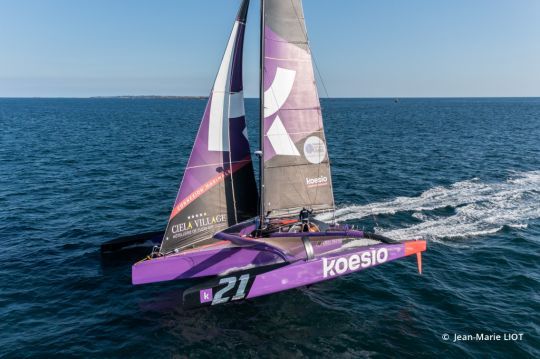
How do you feel about the competition, both in personal and material terms (boat)?
It's going to be very tight, obviously. When you look at all the pairs, it is very homogeneous. There is a huge level. The class has never sailed with so many pairs at this level. It's great. All the skippers are happy, I think, and so are we, to be battling with this level.
Even if today, there is a favorite who has won everything: Leyton with Sam Goodchild and Aymeric Chappellier. It reshuffles the cards. It puts everyone back on the same level, on the same starting line. All the boats can win. And for us, as long as we finish ahead of the second-placed boat, it's perfect! It's a high goal!
After the Transat Jacques Vabre, what are your main projects?
We want to continue sailing this boat and be able to go all the way to the Route du Rhum. Nothing is completely decided yet. We will take advantage of Le Havre to think about it with all the actors of the project who will be present. We'll see what happens next. But the objective is the Rhum on this boat with Koesio.
